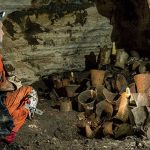Space Exploration
When we send a ship into space, it is always major news. This is because each time we send someone into space, we learn more about what is out there beyond the Earth’s atmosphere. Each time a spaceship goes into orbit, we hope that they will find living, breathing, and even talking forms of life. Many people believe that it is only a matter of time before we find something amazing.
Apollo 14
When the crew of Apollo 14 came back to Earth in 1971, there was very little fanfare from the public. Those within the scientific community were excited, which they often are when a mission returns to Earth. Decades later, scientists discovered that the crew might have brought back something amazing that they weren’t even aware of. The astronauts of Apollo 14 made an amazing discovery, and they didn’t even know it.
Two Years Later
Two years after Neil Armstrong and Buzz Aldrin took their “giant leap for mankind,” NASA had already concluded two lunar missions, but it wasn’t enough. They wanted to send astronauts up a third time, which is how Apollo 14 came to be.
The Crew
The mission crew included Commander Alan Shepard, Command Module Pilot, Stuart Roose, and Lunar Module Pilot, Edgar Mitchell. The prepared for their nine-day visit to the moon. NASA hoped to launch Apollo 14 in October 1970; however, after Apollo 13 failed, they decided to delay the launch by four months. Finally, on January 31, 1971, they took off from Kennedy Space Center.
The Goal
When the crew went into space, they hoped that they would find something that would change the way that the world looked at space and physics. They never expected to make a discovery that would shock the scientific community many years later.
The Landing
On February 5th, the crew landed on the moon. Shepard and Mitchell got out of the ship on their own while Roosa stayed in orbit. For the next 33 hours, the two men worked on the moon. Roosa, while orbiting in the shuttle, took photos of Earth and the moon. He even found the perfect place or Apollo 16 to land. During the mission, they germinated 500 tree seeds, which eventually became known as Moon Trees.
Playing Golf
While on the surface of the moon, Shepherd made a club with some spare junk and whacked a few golf balls. What really changed the mission was the rocks. This was why they were there in the first place. The two men collected over 100 pounds of moon rocks. Scientists couldn’t wait to see and to study the rocks that they brought back. They hoped that they would find answers to the mysteries of outer space.
Landing
Nine days after the ship took off, on February 9th, the Apollo 14 crew landed safely in the Pacific Ocean. When they returned to NASA with their haul, the scientists were eager to get to work. What they didn’t know back then was there was one rock in the haul that had no business of being on the moon. Astronauts find a curious rock on the moon, and it shook the scientific community.
Decades Later
Nobody noticed the strange rock until decades later. NASA loaned the rock to Curtain University in Australia. This happened in 2018, and Professor Alexander Nemchin made a shocking discovery about the rock. It was a 1.8-gram sample that contained granite. Granite is common on Earth, but rarely seen on the moon. It also contained quartz, which was even more unusual for the moon. The zircon grain in the rock was very similar to what is found on Earth. This made everyone wonder how an Earth rock ended up on the moon.
The Theory
Profession Nemchin and his team believe that the rock’s journey began 4 billion years before the Apollo 14 crew arrived on the moon. Back then, asteroids were always slamming into the young Earth, which formed the landmasses that we call home. The moon was three times closer to Earth back then than it is today. Another theory is that the conditions of the moon were much different in its infancy than it is today. Either way, it was a fantastic find. It is a shame that it took many decades for us to figure this out. This has changed the way that we look at the Earth and the moon back when they were first formed. This may not have unlocked the mysteries of outer space, but it has given us a bit more information that we didn’t previously have. This incredible find gives us hope that one day soon, a space mission will answer many of our questions. Only time will tell.


